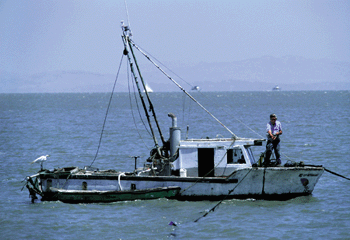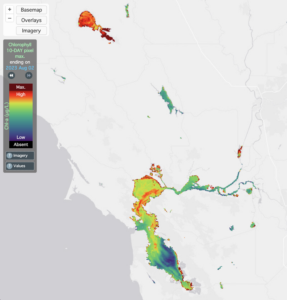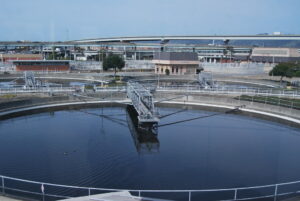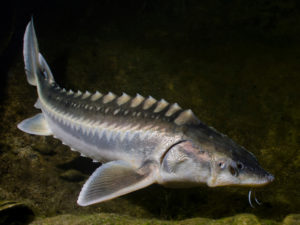It’s an hour before dawn; the Dorothy Ann sways as the tide lifts her out of the mud. Bart Laine must navigate the Alviso Slough as soon as the tide is high enough to float his boat. The bait shop trucks will be waiting when he gets back; he doesn’t waste a minute of his fishing day. “Your money’s out there swimming around and you’ve got to go get it,” he says. The slough is a black river, the tules a ten-foot-high tunnel. Airplanes from three airports wink like fireflies. We reach the open Bay, silent except for the throb of the giant diesel engine beneath our feet, as the horizon glows with the lights of San Jose, San Francisco, the East Bay. Laine’s quarry is the bay shrimp, an essential building block of the Bay’s food web, once fought over as human food, now caught mostly to bait fishermen’s hooks.
The bay (or grass) shrimp (Crangon franciscorum and its relations) has played a crucial supporting role in the life of San Francisco Bay. Shellmounds around the Bay show us that the Ohlone people who lived here ate clams, oysters, and abalone. Accomplished basketmakers, they no doubt scooped shrimp from the Bay. But the Spanish and American settlers paid little attention to shrimp until after the Gold Rush and the completion of the transcontinental railroad. Then Chinese fishermen prospered by netting shrimp until the shrimp fishery became an arena of the decades-long anti-Chinese campaign. Almost all Chinese fishermen were eventually driven off the Bay, while shrimp became just one of many declining species in an ever-shrinking and increasingly polluted Bay. But just as the Bay itself has survived—and even begun to be restored—the bay shrimp has managed to survive, and remains essential food for the Bay’s fish and birds, a day’s work for a few commercial shrimpers, and bait for Bay Area fishing families.
At China Camp, northeast of San Rafael, a few buildings of the Point San Pedro fishing village are now a state park. (“B” movie buffs can see a romantic reconstruction of how it might have looked by renting Blood Alley, a 1954 “Red Scare” melodrama starring John Wayne and Lauren Bacall.) Frank Quan’s grandfather owned the general store in the village in 1895, and Quan has lived here all his life. In the 1930s, eight or ten boats fished for shrimp off the point. Now Quan’s boat rocks alone at the pier.
- Frank Quan, the last remainng shrimp fisherman at Point San Pedro, readies his boat for another day of fishing in the North Bay. Photos by Scott Braley
“The catch is terrible this year,” says Quan, looking out on a warm August afternoon. “The winter was too dry, and the farmers want all that water going into the San Joaquin Valley for the crops. You see how blue the water is? That’s because it’s mostly ocean. It should be murky, full of river water. No shrimp around here. We’re fishing way up at the mouth of the Petaluma River. Lucky if we catch sixty pounds a day. If there’s no fresh water in the Bay, there’s no shrimp in the Bay.”
Quan still fishes—”a bad habit I can’t break,” he says, smiling—and sells his catch live for bait. A century ago locally caught bay shrimp were served like pretzels in huge bowls in the bars. But today Quan’s catch can sell for almost twice as much as live bait than as food in local markets, so the shrimp he serves at the China Camp diner he runs with his cousin Georgette Quan Dahlka is mostly purchased frozen from the fish market.

- Site of the former Point San Pedro Chinese fishing village, now part of China Camp State Park. Photo by Scott Braley.
Bart Laine also comes from a shrimping family. His father fished for bay shrimp for 30 years and still harvests the tiny brine shrimp that grow in South Bay salt ponds. Laine operates from the Alviso Marina, a ramshackle collection of floating docks where the Guadalupe River meanders into the Bay at its southeastern tip, near San Jose. He worries about too much fresh water in his part of the Bay, especially when runoff from a rainy winter is added to the outflow from the nearby sewage plant.
Laine complains about the South Bay being too fresh; Quan says the North Bay is too salty this year. Research confirms both their concerns: Bay shrimp are finicky about salinity and temperature, and they adapt to life in and near the Bay in a complex cycle of migration, breeding, and even sex changes.
All local bay shrimp species (there are six in all) like brackish water. Salt concentration in the open ocean is about 35 parts per thousand (ppt); in the Sacramento River it is less than half a part per thousand (0.5 ppt). C. franciscorum, historically the most common and the fishermen’s favorite, prefer about 14 parts per thousand (ppt) as juveniles, up to about 24 ppt when they are ready to breed. The other species are more salt tolerant, so they tend to be more abundant when fresh water is scarcer. C. franciscorum likes a water temperature around 18 degrees centigrade (about 65 degrees Fahrenheit); the species that prefer a saltier environment like cooler water.
Bay shrimp are a restless bunch, migrating dozens of miles from near-coastal ocean to intertidal flats, seeking their preferred salinity and temperature combination for different phases of their lives. When winter rains begin, mature females leave the marshy shallows for the deeper, colder, saltier water of the central Bay or the Gulf of the Farallones just outside the Golden Gate, breeding with males who have been hanging out downstream from them in a slightly saltier environment. The females incubate 2,000 to 8,000 eggs for eight to twelve weeks. The zooae (larval shrimp) shed their skins five to seven times before reaching about a centimeter in length. These young shrimp migrate dozens of miles back to the warmer, shallower, and less salty estuarine and tidal shallows. They swim; they walk on the bottom; they hitchhike on the incoming tides, hunkering down in the mud against the outgoing tides. The ones who make it to the shallows eat and grow to 6.5 or 7 centimeters before they migrate back to the depths.
It’s a short life cycle, a year to a year and a half for males (one spawning cycle), as much as two and a half years for the female (two spawning cycles). Some researchers believe several shrimp species, C. franciscorum in particular, are “protandrous hermaphrodites”; that is, the surviving males become females after the first year. Females appear to live longer than males; this sex change strategy may account for the apparent disappearance of the males after the first year.
Bay shrimp play an essential role in the Bay’s food web. Everyone, from the graceful white egret fishing at the shoreline to the 100-year-old sturgeon patrolling the bottom of the Bay, eats shrimp or the creatures that live on the shrimp. All the species of grass shrimp are a favorite food of striped bass, Dungeness crab, and Pacific tom cod (“red snapper”).
Shrimp themselves are omnivorous, consuming smaller organisms in the benthos, the mud layer at the bottom of the Bay. They also consume algae; in an abundant year, growing shrimp eat the algae that blooms where fresh water from storm drains and sewage treatment plants pours into the Bay.
The shrimp population in a given year depends pretty directly on how much fresh water is flowing in to the Bay estuary, a factor determined by both weather and state water policy. The California Department of Fish and Game has kept systematic records of the Bay’s denizens only since 1980. It uses a complicated index that compares relative populations of creatures from year to year, and confirms both historical reports and fishermen’s observations of wide variations in population. For example, the C. franciscorum population in 1996, a wet year following a wet year, was 20 times that of 1980. The lowest years were 1985 and 1992; populations fell consistently during the 1987 to 1992 drought
Historical data is spotty, but 19th-century observers describe a Bay teeming with shrimp, nine-tenths of them C. franciscorum. Commercial shrimp fishing became significant in the 1870s, when Chinese men who had worked on the railroads looked for other ways to make a living. Many of the Chinese in California came from Canton, a province of fisherfolk along the mighty Pearl River and South China Sea, where shrimp were part of the diet. The former fishermen organized self-sufficient villages around the Bay, built boats and nets according to their traditional methods, and eventually harvested millions of pounds of shrimp.
The shrimp camps were mostly all-male societies with few amenities. A few, including Point San Pedro, became real villages, with families, stores, teachers, barbers, and a physician. Although residents found other kinds of labor in the slack season (such as digging potatoes and clams), the camps’ existence depended on shrimping.
The camps did have some community life, as shrimpers worked and relaxed together. John C. Muir of the San Francisco Maritime Museum describes the rhythm of the work at Point San Pedro. Each junk had a crew of four to six men who loaded bag nets and shrimp baskets and cast off at the first lift of the tide. They sailed or rowed north to the Petaluma Flats, where each crew set as many as 60 bag nets, staking them to the bottom with long poles. The boats coordinated their cone-shaped nets in a line up to a mile long on the muddy bottom, the wide end facing the current, trapping the shrimp as the tide moved through the bags. Once the backbreaking work of setting the nets was done, the junks circled close together and their crews cooked, drank tea, and relaxed as the rising tide swept the shrimp into the nets. At the next slack tide the crews hauled in the nets, and dozens of hands sorted the shrimp by size, throwing small fish back into the Bay. A junk was waiting at the dock to sail the largest shrimp live to San Francisco’s Chinatown; the rest of the catch was unloaded, boiled, and dried, then shipped to Hawaii and China. Except for the camp’s real estate, which Chinese were not allowed to own, the shrimp industry was completely in Chinese hands, from laborers to merchants to the shipping companies (the most profitable part of the enterprise).
The 1870s and 1880s were difficult decades in California. The railroads made a few white men—Leland Stanford, Collis Huntington, Charles Crocker, Mark Hopkins—very rich. But the railroad brought a flood of cheap goods from the East, ruining California’s infant manufacturing economy and throwing many people out of work. Unemployed railroad workers—white (mostly Irish) as well as Chinese—joined the ex-forty-niners and out-of-work sailors in a depressed San Francisco.
Lean times can be mean times, and the 1870s were bitter years; the Chinese were prime targets of displaced white workingmen. Race riots and unexplained fires in Chinese neighborhoods were common, and anti-Chinese workers’ groups flourished. Three days of rioting in July 1877 cost hundreds of Chinese lives. Although the violence was suppressed, newspapers and public officials clamored to force Chinese people out of California.
Efforts to drive the Chinese from the shrimp fishery started as early as 1862, when white fishermen unsuccessfully petitioned the state government to impose special taxes on Chinese fishermen. In 1874, a state Commission on Fisheries concluded that unrestrained shrimp fishing would threaten the food supply of ocean fish that came into the Bay to feed.
After the 1877 riots, hostility to the shrimpers mounted. In 1880 the Legislature outlawed Chinese shrimp fishing altogether, but this law was declared unconstitutional. So the Legislature tried to regulate Chinese shrimpers out of existence by outlawing their methods, especially the bag net. In 1884 another commission found “the catch of all kinds of fish will decrease . . . in the next five years if the Chinese are allowed to fish with . . . bag nets.” Historian Mitchell Postel tells us, “Between 1884 and 1900, the [California State] commission [on Fisheries] carried on a virtual war on Chinese fishing methods.” The number of shrimp camps fell, from as many as 50 during the 1880s to 26 by 1897.
Scapegoating the Chinese was not just ugly; it also took the place of any systematic inquiry into the many factors that were making the Bay less productive. It’s certainly possible that the highly efficient shrimp fishery, which landed 5 million pounds of shrimp at its 1892 peak, overfished the shrimp. But no one knew, then or now, how big a harvest was “too big” or how long it would take for the population to recover.
Other factors that insulted the Bay and depressed its fisheries—hydraulic mining in the Sierras, logging off the East Bay hills, untreated sewage, freshwater diversion for municipal utility districts—went largely unexamined in what historian Gray Brechin calls the imperial atmosphere of a rapidly growing San Francisco. The Bay’s tidal wetlands—shrimp nursery habitat—were reduced to a fraction of their 1850 extent by diking for farmland. No one knows how much these factors altered the salinity of the Bay and stressed the shrimp and fish populations. However, the evident decline of the fisheries testifies to the Bay’s deterioration: By the time records began to be kept in the late 1800s, the catch of all kinds was falling.
The outlawing of bag nets in 1911 was the coup de grace for the crippled Chinese shrimping industry. The fishery did not disappear, however; it just changed hands and technology: motorized boats using beam trawls which skimmed the Bay floor just above the mud replaced sailboats and bag nets. A few Chinese fishermen, the Quans among them, converted to the new technology. The retooled shrimp fishery rebounded, to a catch of 3.5 million pounds in 1935. Now that it was not in the hands of the Chinese, no one claimed that it endangered other fish populations.
Quan remembers going out for one last catch before he left for the Navy in 1942, and how low the boat rode with its full load. “Never caught that much in one day again.” The catch declined steeply after he came home from the war, and shrank steadily as the California Water Project took ever more of the Sacramento River for the farms of the Central Valley. Quan recalls that in the early 1960s the catch was still big enough to sell to Alioto’s for Fisherman’s Wharf shrimp cocktails. Shortly thereafter, in 1964, the catch plummeted to almost nothing.
The shrimp population has begun to recover somewhat as environmentalists and fishermen have convinced the public and officials that the Bay is a unique resource to be preserved and reclaimed. Kathryn Hieb, marine fishery biologist with the California Department of Fish and Game, says that a cleaner Bay and restored wetlands provide a healthier general environment for shrimp. She believes that ongoing efforts by environmentalists, fishermen, and others to guarantee greater amounts of fresh water for the Bay will be a major determining factor in the size of the estuary’s shrimp populations in the future.
Today a handful of commercial fishermen shrimp in the Bay, catching between 100,000 and 200,000 pounds a year. They mostly operate alone, regulated closely by Fish and Game. Still, the work itself is little changed from a century ago, face to face with the wind, the tide, the water, and the shrimp.
Bart Laine lowers the beam that holds his net. Chains attached to the net hit the mud and startle the shrimp, which jump up into the net. After half an hour, he raises the trawl’s two ends into a bag of squirming seafood, which he dumps into tanks full of furiously aerated Bay water. He scoops out a few pounds and spreads the squirming mass out on a big table, quickly picking out the small fish and tossing them back into the water. As the boat chugs slowly back for the next pass, Laine sifts his catch. By the time he docks, five-gallon pails full of shrimp are ready for the tanks of the waiting bait company trucks, which will deliver them live to bait shops from Petaluma to Stockton.
Shrimp have survived a century and a half of intensive fishing, diking, bay fill, pollution, and freshwater diversion. They have survived in spite of policies dictated more by economic interests, political pressure, and racial discrimination than by environmental science. However, public agencies and allied scientific institutions now have a mandate—and some funding—to study the lives of shrimp and other creatures that make their homes in the Bay and are essential components of a healthy estuary. Their findings may help explain what the fishermen experience as they work every day. From the mute testimony of the bay shrimp, from the careful research of the marine biologists, and from the accumulated wisdom of veteran fishermen like Frank Quan and Bart Laine will come the knowledge we need to shape a realistic and holistic vision for our relationship to the Bay in years to come.

.jpg)




